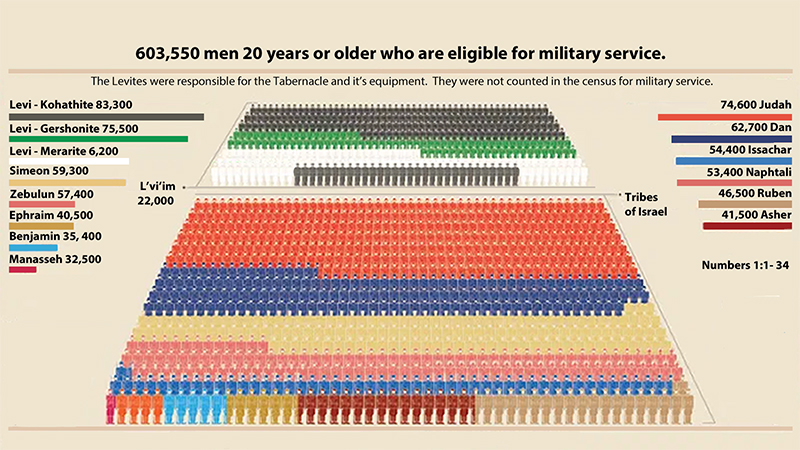 This weeks Bible section reveals something about the relationship of believers from the nations with God and with Israel. The setting for this section is Mt. Sinai. Israel had been at Sinai for almost a year and was preparing to depart for the “Promised Land”. As they were being prepared to enter the land, God ordered that the men suitable for military service be numbered. Men from 20 years old were numbered. This speaks to the idea of an age of accountability. We believe that God ordered the men to be numbered to serve as a testimony to future generations and to assign responsibility to each individual.
This weeks Bible section reveals something about the relationship of believers from the nations with God and with Israel. The setting for this section is Mt. Sinai. Israel had been at Sinai for almost a year and was preparing to depart for the “Promised Land”. As they were being prepared to enter the land, God ordered that the men suitable for military service be numbered. Men from 20 years old were numbered. This speaks to the idea of an age of accountability. We believe that God ordered the men to be numbered to serve as a testimony to future generations and to assign responsibility to each individual.
Levites were omitted from this numbering process. They were treated separately because they were set aside for special service to God. They rendered help to the Priests and handled the work around the tabernacle. Levites had replaced the firstborn sons of Israel due to the rebellion concerning the “Golden Calf”. Evidently, the firstborn sons of the tribes had forfeited their natural leadership position by failing to oppose idolatry. The function of the Levites was to “come near to God” and to handle the things of God. Please note that the Levites were numbered from one month old and older. They “belonged” to God for their entire life.
Later, King David instituted continual praise and worship in the tent that he erected when he brought the Ark to Jerusalem (I Chronicles 15-16). The duties of the Levites were expanded to include this praise and worship. Musicians and singers ministered continually before the Ark which, of course, represented the throne of God. These practices were continued during the first and second Temple eras.
We believe that real believers from the nations (followers of Messiah Jesus) have been called to a parallel function. The true essence of such believers is to “know” God (John 17:3). The word, know, here means much more than a simple intellectual knowledge; it means an experiential knowledge. This is much more profound than simply adopting a Christian creed or adopting a Christian philosophy of life.
The format for Christian worship was also defined by the pattern set by King David in the tent in Jerusalem. David must have been given a vision of heavenly worship. John recorded a vision of worship by the host of angelic beings as well as the redeemed before the throne of God (Revelation 4-5). This pattern of worship should serve as a vision for any church body. As the church offers up praise to God, their head, Jesus the Messiah, brings them into the Most Holy Place in worship. This is Davidic worship.
We are now approaching the second major festival established in terms of days, weeks and months on God’s calendar. This is Shavuot. Shavuot falls on the anniversary of the date when God cut a covenant with Israel at Mt. Sinai. It is also the anniversary of the date when God separated believers (~ 1479 years later) who would be the followers of Messiah Jesus. God indwelled these believers and they “experienced” Him (to know God as referenced above) in an awesome personal way.
I consider the small book of Ruth to be the first book of prophecy in the Bible. It illustrates how believers from the nations must relate to Israel and to the God of Israel. Ruth represents true spirit-filled believers who become special servants not only of Israel but also to God. Ruth gleaned in the fields to help sustain Naomi (symbolic of Israel returning to her land from the dispersion) and also became the great-grandmother of King David who uniquely foreshadowed Messiah Jesus. In the same account traditional Christianity is portrayed by Orpah. She had the opportunity to serve but turned back when it became evident that there was apparently nothing for her in association with Israel and its God.
Are you an Orpah or a Ruth?